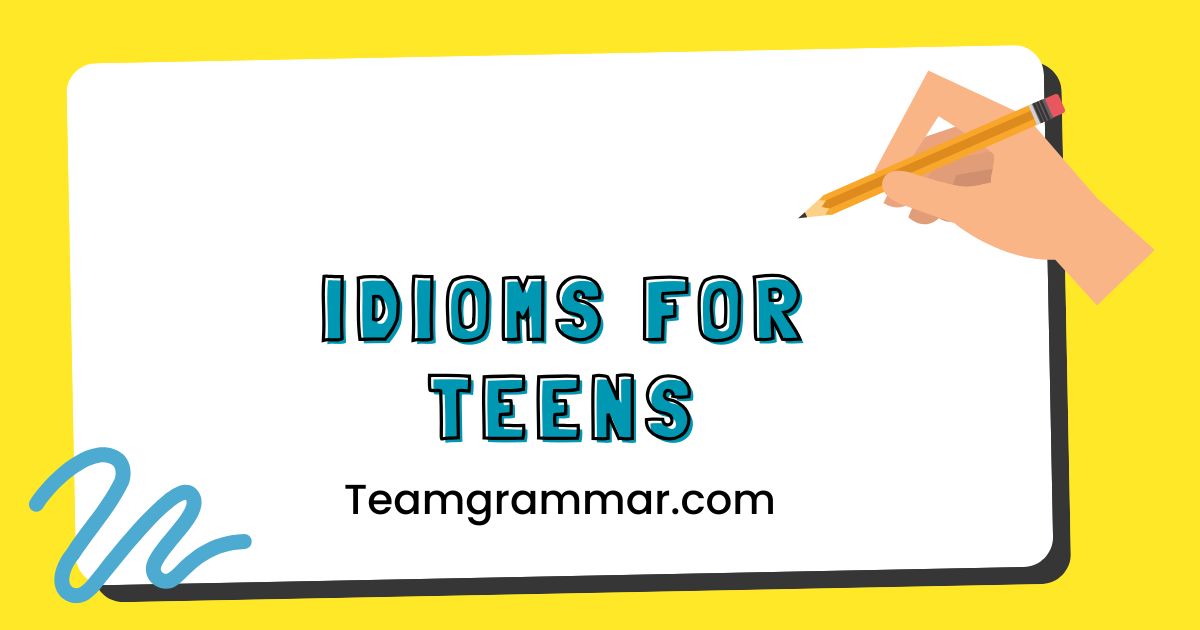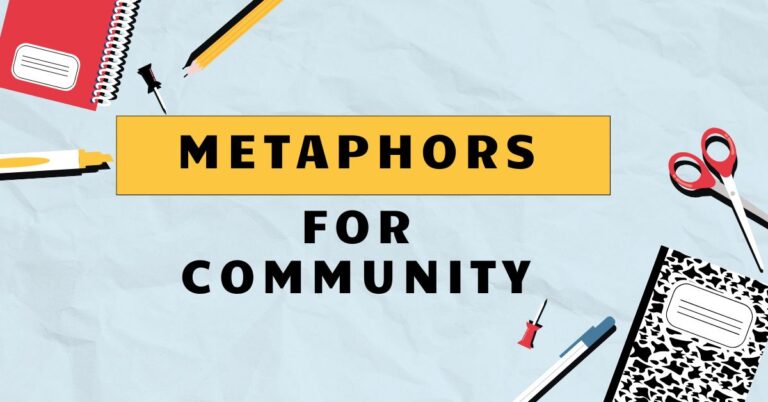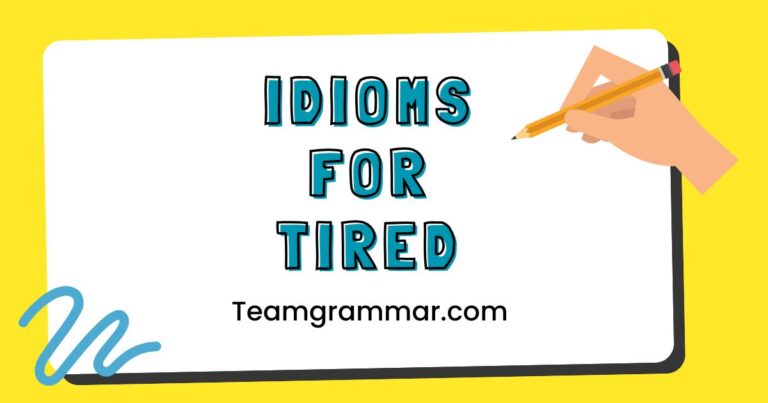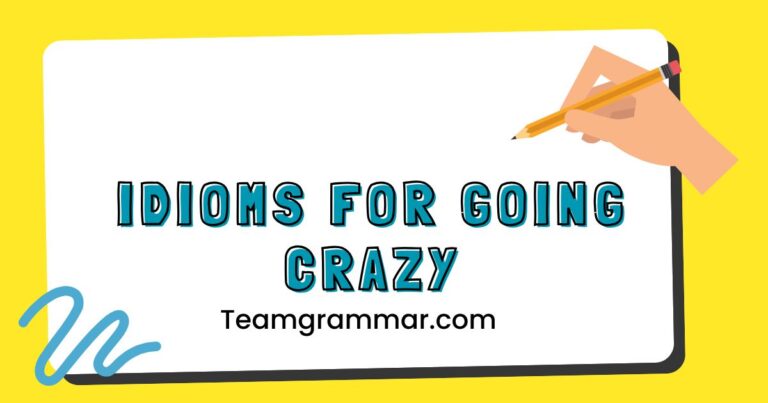45 Idioms for Teens: Mastering Everyday English Expressions
Idioms are colorful expressions that add flavor to the English language, but they can also be tricky to understand if you’re not familiar with them. This article will help you, as a teen, navigate the world of idioms, making your conversations more engaging and your comprehension of English literature and media much stronger.
Understanding idioms is crucial for effective communication and cultural understanding, especially as you interact with native English speakers. This guide breaks down what idioms are, how they work, and provides plenty of examples to help you master them.
Whether you’re an ESL student or a native speaker looking to enhance your vocabulary, this guide is for you.
Table of Contents
- 1. What are Idioms?
- 2. Structural Breakdown of Idioms
- 3. Types of Idioms
- 4. Examples of Common Idioms for Teens
- 5. Usage Rules for Idioms
- 6. Common Mistakes with Idioms
- 7. Practice Exercises
- 8. Advanced Topics in Idioms
- 9. Frequently Asked Questions (FAQs)
- 10. Conclusion
1. What are Idioms?
An idiom is a phrase or expression whose meaning cannot be understood from the ordinary meanings of the words within it. In simpler terms, it’s a saying that means something different from what it literally says.
Idioms are a crucial part of everyday English, adding richness and nuance to conversations. They often reflect cultural values and historical contexts, making them fascinating to study.
Understanding idioms helps you not only comprehend spoken and written English better but also communicate more effectively and naturally.
Idioms are often confused with other figures of speech like metaphors and similes. While these also use figurative language, idioms have a fixed meaning that is widely recognized.
For example, “to be in the same boat” doesn’t literally mean you’re on a boat; it means you’re in the same difficult situation as someone else. Recognizing and correctly using idioms demonstrates a strong command of the English language.
1.1 Classification of Idioms
Idioms can be classified based on their structure and the way they convey meaning. Some idioms are metaphorical, using comparisons to create a vivid image, while others are simply fixed expressions with no clear logical connection to their meaning.
Understanding these classifications can help you remember and use idioms more effectively.
One common classification is based on the part of speech the idiom functions as. For instance, some idioms act as verbs (e.g., “kick the bucket”), while others act as nouns (e.g., “a piece of cake”) or adjectives (e.g., “on cloud nine”).
Recognizing the grammatical role of an idiom can help you integrate it correctly into your sentences.
1.2 Function of Idioms
Idioms serve several important functions in communication. They add color and expressiveness to language, making it more engaging and memorable.
They can also convey complex ideas in a concise and relatable way. Furthermore, using idioms appropriately demonstrates cultural awareness and a deeper understanding of the English language.
Idioms can also be used to soften harsh realities or to express emotions indirectly. For example, instead of saying someone died, you might say they “passed away” or “kicked the bucket.” The choice of idiom can significantly impact the tone and impact of your message.
1.3 Contexts of Use
Idioms are used in a wide variety of contexts, from casual conversations to formal writing. However, it’s important to be aware of the appropriateness of using idioms in different situations.
Highly informal idioms might be suitable for talking to friends but not for writing a school essay. Understanding the context in which an idiom is used is crucial for interpreting its meaning correctly.
The context can also provide clues to the meaning of an unfamiliar idiom. Pay attention to the surrounding words and the overall situation to help you decipher what the speaker or writer is trying to convey.
With practice, you’ll become more adept at recognizing and understanding idioms in various contexts.
2. Structural Breakdown of Idioms
Idioms can be structurally diverse, ranging from simple two-word phrases to more complex sentences. Understanding the structure of an idiom can sometimes provide clues to its meaning, although the meaning is usually non-literal.
Recognizing common patterns can help you learn and remember idioms more easily.
Some idioms follow a specific grammatical structure, such as “the [comparative] the [comparative]” (e.g., “the more, the merrier”). Others are based on common verb-preposition combinations (e.g., “look up to”).
By analyzing the structure of an idiom, you can often identify its key components and understand how they work together to create a unique meaning.
2.1 Key Structural Elements
The key structural elements of an idiom include the individual words, their grammatical relationships, and the overall pattern of the phrase. Some idioms contain specific words that are essential to their meaning, while others can be varied slightly without changing the overall sense.
Identifying these key elements is crucial for understanding and using idioms correctly.
For example, in the idiom “hit the nail on the head,” the words “hit,” “nail,” and “head” are all essential. Changing any of these words would alter the meaning or make the idiom nonsensical.
Recognizing these key elements helps you avoid misusing or misunderstanding the idiom.
2.2 Common Idiomatic Patterns
Several common patterns appear in idioms. These include:
- Verb + Preposition: look up to, get away with
- Adjective + Noun: a dark horse, a cold shoulder
- Two Nouns Connected by a Preposition: the apple of one’s eye, a fish out of water
- Phrases with Comparisons: as cool as a cucumber, as busy as a bee
Recognizing these patterns can help you categorize and remember idioms more effectively. It also allows you to anticipate the meaning of new idioms based on their structure.
3. Types of Idioms
Idioms can be categorized in several ways, including by their meaning, origin, and grammatical structure. Understanding these categories can help you appreciate the diversity and richness of idiomatic expressions.
It also allows you to choose the most appropriate idiom for a given situation.
Some idioms are based on historical events or cultural practices, while others are derived from metaphors or similes. By exploring the origins of idioms, you can gain a deeper understanding of their meaning and usage.
3.1 Meaning-Based Categories
Idioms can be grouped based on the type of meaning they convey. Some common categories include:
- Expressions of Emotion: on cloud nine, down in the dumps
- Expressions of Difficulty: a hard nut to crack, an uphill battle
- Expressions of Success: hit the jackpot, make a killing
- Expressions of Failure: fall flat, go down in flames
Understanding these meaning-based categories can help you choose the most appropriate idiom to express a particular emotion or idea.
3.2 Origin-Based Categories
Idioms often have interesting origins, reflecting historical events, cultural practices, or literary references. Some common categories based on origin include:
- Literary Idioms: derived from famous works of literature, such as “catch-22” (from Joseph Heller’s novel)
- Historical Idioms: originating from historical events or practices, such as “bury the hatchet” (from Native American traditions)
- Sports-Related Idioms: derived from sports, such as “ballpark figure” or “hit below the belt”
Exploring the origins of idioms can provide valuable insights into their meaning and usage. It also adds an element of cultural and historical awareness to your understanding of the English language.
4. Examples of Common Idioms for Teens
This section provides numerous examples of idioms commonly used by and understood by teenagers. Each idiom is presented with its meaning and example sentences to illustrate its use in context.
Mastering these idioms will greatly enhance your ability to communicate effectively with your peers and understand popular culture.
These idioms cover a wide range of topics, from school and social life to emotions and personal experiences. By studying these examples, you’ll gain a solid foundation in idiomatic English and be able to use them confidently in your own conversations and writing.
4.1 Idioms Related to Teen Life
These idioms are frequently used in the context of school, friendships, and social activities. Understanding these expressions will help you navigate the often complex world of teen life.
| Idiom | Meaning | Example Sentence |
|---|---|---|
| All-nighter | Staying up all night to study or work. | I had to pull an all-nighter to finish my science project. |
| Hang out | To spend time with friends, usually informally. | We’re going to hang out at the mall this weekend. |
| Piece of cake | Something that is very easy. | The test was a piece of cake; I finished it in 20 minutes. |
| Hit the books | To study hard. | I need to hit the books if I want to pass this exam. |
| Couch potato | Someone who spends a lot of time sitting and watching television. | Don’t be such a couch potato; let’s go outside and play. |
| Cool as a cucumber | Very calm and relaxed, especially in a stressful situation. | Even though the pressure was on, she remained as cool as a cucumber. |
| Break a leg | Good luck (said to someone before a performance). | You have your audition tonight? Break a leg! |
| In the dog house | In trouble with someone, usually a romantic partner. | I forgot our anniversary, so I’m really in the dog house. |
| Cost an arm and a leg | Very expensive. | That new phone cost an arm and a leg! |
| Once in a blue moon | Very rarely. | I only see my cousins once in a blue moon. |
| Under the weather | Feeling ill. | I’m feeling a bit under the weather today, so I’m staying home. |
| Wrap your head around something | To understand something complicated. | I’m trying to wrap my head around this physics problem. |
| Rule of thumb | A general principle based on practice rather than theory. | As a rule of thumb, you should always back up your computer files. |
| Get something off your chest | To talk about something that has been bothering you. | I need to get something off my chest; can we talk? |
| Hit the nail on the head | To be exactly right about something. | You hit the nail on the head when you said I was stressed about the exam. |
| Miss the boat | To miss an opportunity. | If you don’t apply now, you’ll miss the boat. |
| On the ball | Alert and competent. | Our new team member is really on the ball. |
| Up in the air | Undecided or uncertain. | Our plans for the summer are still up in the air. |
| Burning the midnight oil | Working or studying late into the night. | She’s been burning the midnight oil to finish her thesis. |
| In a pickle | In a difficult situation. | I’m in a pickle because I forgot my homework. |
| A hot potato | A controversial issue. | Climate change is a hot potato in the political debate. |
| A penny for your thoughts | What are you thinking about? | You seem quiet. A penny for your thoughts? |
| Bite the bullet | To face a difficult situation with courage. | I didn’t want to go to the dentist, but I had to bite the bullet. |
| Get your act together | To organize yourself and start behaving properly. | You need to get your act together if you want to succeed. |
| Jump the gun | To do something too early, without thinking carefully about it. | They jumped the gun and announced the news before it was confirmed. |
The table above presents a range of idioms commonly used in the context of teen life. Each entry includes the idiom itself, its meaning, and an example sentence to illustrate how it’s used.
These idioms are essential for understanding conversations and media relevant to teenagers.
4.2 Idioms for Expressing Emotions
These idioms are useful for describing your feelings and understanding how others express their emotions. They add color and depth to your emotional vocabulary.
| Idiom | Meaning | Example Sentence |
|---|---|---|
| On cloud nine | Extremely happy. | She was on cloud nine after winning the competition. |
| Down in the dumps | Feeling sad or depressed. | He’s been down in the dumps since his team lost the game. |
| Butterflies in my stomach | Feeling nervous or anxious. | I have butterflies in my stomach before my presentation. |
| Mad as a hatter | Completely crazy or eccentric. | He’s been acting as mad as a hatter ever since he lost his job. |
| Tickled pink | Very pleased or amused. | She was tickled pink to receive the award. |
| Green with envy | Jealous. | I was green with envy when I saw her new car. |
| Head over heels | Deeply in love. | They are head over heels for each other. |
| Feeling blue | Feeling sad. | I’m feeling blue today because it’s raining. |
| Over the moon | Extremely happy. | She was over the moon when she got accepted to college. |
| Have a blast | To have a great time. | We had a blast at the party last night. |
| Bored stiff | Extremely bored. | I was bored stiff during the lecture. |
| Fed up | Annoyed or frustrated. | I’m fed up with this constant rain. |
| Scared stiff | Extremely frightened. | I was scared stiff when I heard the loud noise. |
| Happy-go-lucky | Carefree and cheerful. | He’s a happy-go-lucky kind of guy. |
| On edge | Anxious and irritable. | I’ve been on edge all day waiting for the news. |
| See red | To become very angry. | I saw red when he insulted my friend. |
| Keep your chin up | Stay positive. | Even though things are tough, you need to keep your chin up. |
| Wear your heart on your sleeve | To openly show your emotions. | She wears her heart on her sleeve, so everyone knows how she feels. |
| Cry your eyes out | To cry a lot. | I cried my eyes out when I watched that sad movie. |
| Grin and bear it | To accept something unpleasant without complaining. | I didn’t like the food, but I just grinned and bore it. |
| Hit rock bottom | To reach the lowest point in a situation. | After losing his job, he felt like he had hit rock bottom. |
| A shoulder to cry on | Someone who provides comfort and support. | She’s always been a shoulder to cry on for me. |
| Get something off your chest | To talk about something that’s been bothering you. | It’s good to get something off your chest and talk about your feelings. |
| Keep a stiff upper lip | To remain brave and not show emotion. | During the difficult times, he kept a stiff upper lip. |
The table above lists idioms that vividly describe different emotions. Each idiom is accompanied by its meaning and a clear example, enabling you to express your feelings more precisely and understand the emotional nuances in conversations.
4.3 Idioms for Giving Advice
These idioms are commonly used when offering suggestions or guidance to others. They provide a concise and memorable way to convey important advice.
| Idiom | Meaning | Example Sentence |
|---|---|---|
| Bite off more than you can chew | To take on more than you can handle. | Don’t bite off more than you can chew; start with a manageable workload. |
| Cross that bridge when you come to it | Deal with a problem when it arises. | Let’s not worry about the details now; we’ll cross that bridge when we come to it. |
| Don’t count your chickens before they hatch | Don’t be too confident about something that might not happen. | We haven’t won the contract yet, so don’t count your chickens before they hatch. |
| Don’t put all your eggs in one basket | Don’t risk everything on a single venture. | It’s wise to diversify your investments; don’t put all your eggs in one basket. |
| Look before you leap | Think carefully before taking action. | Look before you leap; consider the consequences before making a decision. |
| A bird in the hand is worth two in the bush | It’s better to hold onto something you have than to risk losing it by trying to get something better. | I was offered a new job, but I decided to stick with my current one because a bird in the hand is worth two in the bush. |
| When it rains, it pours | When bad things happen, they tend to happen all at once. | First I lost my job, and then my car broke down; when it rains, it pours. |
| Actions speak louder than words | What you do is more important than what you say. | He says he’ll help, but actions speak louder than words. |
| Better late than never | It’s better to do something late than not at all. | I know I’m late with the assignment, but better late than never. |
| Easy come, easy go | Something gained easily is easily lost. | I won the lottery, but I spent it all quickly; easy come, easy go. |
| Every cloud has a silver lining | There’s something positive in every bad situation. | Even though you lost the game, every cloud has a silver lining; you played well. |
| Practice makes perfect | The more you practice, the better you’ll become. | Don’t worry if you don’t get it right away; practice makes perfect. |
| Rome wasn’t built in a day | Important things take time to achieve. | Be patient with your progress; Rome wasn’t built in a day. |
| The early bird catches the worm | The person who starts something early has the best chance of success. | I got to the store early and found everything I needed; the early bird catches the worm. |
| Two wrongs don’t make a right | Responding to a wrong with another wrong will not make things better. | Don’t retaliate; two wrongs don’t make a right. |
| When in Rome, do as the Romans do | Adapt to the customs of the place you’re in. | We should try the local cuisine; when in Rome, do as the Romans do. |
| You can’t judge a book by its cover | You shouldn’t judge something by its outward appearance. | He may seem shy, but you can’t judge a book by its cover. |
| Where there’s a will, there’s a way | If you’re determined, you can find a way to achieve something. | If you really want to succeed, where there’s a will, there’s a way. |
| Better safe than sorry | It’s better to be cautious than to take a risk. | I’m going to bring an umbrella, better safe than sorry. |
| Don’t cry over spilt milk | Don’t worry about something that has already happened and cannot be changed. | The mistake is already made, so don’t cry over spilt milk. |
This table offers idioms commonly used to give advice. Each idiom is defined and illustrated with an example sentence, making it easier to understand and use these expressions when offering guidance or suggestions.
5. Usage Rules for Idioms
Using idioms correctly requires understanding their specific meanings and contexts. While idioms can add color and expressiveness to your language, using them inappropriately can lead to confusion or miscommunication.
This section outlines the key rules for using idioms effectively.
It’s important to consider your audience and the formality of the situation when choosing an idiom. Some idioms are more appropriate for casual conversations, while others are suitable for more formal settings.
Being mindful of these nuances will help you communicate more effectively.
5.1 Context and Appropriateness
The most important rule for using idioms is to ensure they are appropriate for the context. Consider the formality of the situation, the relationship with your audience, and the overall tone of your message.
Avoid using highly informal or slangy idioms in formal settings, such as school presentations or job interviews.
For example, saying “I aced the test” is fine among friends, but in a formal email to a teacher, it would be better to say “I performed well on the test.” Understanding these distinctions is crucial for effective communication.
5.2 Literal vs. Figurative Meaning
Always remember that idioms have a figurative meaning that is different from the literal meaning of the words. Avoid interpreting idioms literally, as this will lead to misunderstandings.
Instead, focus on the established meaning of the idiom as a whole.
For instance, “break a leg” literally means to injure someone’s leg, but figuratively it means “good luck.” Understanding this distinction is essential for interpreting and using idioms correctly.
5.3 Grammatical Structure and Flexibility
While idioms are generally fixed expressions, some allow for slight variations in their grammatical structure. However, it’s important to be aware of the limits of this flexibility.
Changing the words or structure of an idiom too much can alter its meaning or make it nonsensical.
For example, you can say “pull someone’s leg” or “are you pulling my leg?” but you can’t say “pull the leg of someone” without sounding awkward. Pay attention to the common variations of idioms and avoid making unnecessary changes.
6. Common Mistakes with Idioms
Even advanced English learners sometimes make mistakes when using idioms. These mistakes often stem from misinterpreting the meaning of an idiom, using it in an inappropriate context, or altering its grammatical structure incorrectly.
This section highlights some of the most common mistakes and provides correct alternatives.
By being aware of these common pitfalls, you can avoid making similar errors and use idioms more confidently and accurately.
6.1 Misinterpreting the Meaning
One of the most common mistakes is misinterpreting the meaning of an idiom. This can happen if you try to understand the idiom literally or if you confuse it with a similar-sounding expression.
Always double-check the meaning of an unfamiliar idiom before using it.
Incorrect: “I’m feeling under the chair today.” (Misinterpreting “under the weather”)
Correct: “I’m feeling under the weather today.”
6.2 Using Idioms in the Wrong Context
Using an idiom in an inappropriate context can make your communication sound awkward or unprofessional. Always consider the formality of the situation and the relationship with your audience before using an idiom.
Incorrect: “The CEO kicked the bucket last night.” (Too informal for a news report)
Correct: “The CEO passed away last night.”
6.3 Making Grammatical Errors
Altering the grammatical structure of an idiom incorrectly can change its meaning or make it nonsensical. Stick to the established structure of the idiom and avoid making unnecessary changes.
Incorrect: “Hit the head on the nail.” (Incorrect word order)
Correct: “Hit the nail on the head.”
7. Practice Exercises
These exercises will help you test your understanding of idioms and practice using them correctly. Each exercise focuses on a different aspect of idiomatic language, from identifying the meaning of idioms to using them in context.
Complete these exercises to reinforce your knowledge and build your confidence in using idioms effectively.
7.1 Exercise 1: Matching Idioms to Their Meanings
Match the idioms in Column A with their meanings in Column B.
| Column A (Idiom) | Column B (Meaning) | Answer |
|---|---|---|
| 1. Break a leg | a. To be very happy | |
| 2. Piece of cake | b. To understand something complicated | |
| 3. Wrap your head around something | c. Good luck | |
| 4. On cloud nine | d. Very rarely | |
| 5. Once in a blue moon | e. Something very easy |
Answers: 1-c, 2-e, 3-b, 4-a, 5-d
7.2 Exercise 2: Fill in the Blanks
Complete the following sentences with the correct idiom from the list below.
Idiom List: cost an arm and a leg, under the weather, hit the books, in the dog house, couch potato
| Question | Answer |
|---|---|
| 1. I’m feeling a bit ________ today, so I’m staying home. | |
| 2. That new car ________! | |
| 3. I need to ________ if I want to pass this exam. | |
| 4. Don’t be such a ________; let’s go outside. | |
| 5. I forgot our anniversary, so I’m ________. |
Answers: 1. under the weather, 2. cost an arm and a leg, 3. hit the books, 4. couch potato, 5. in the dog house
7.3 Exercise 3: Using Idioms in Context
Write a sentence using each of the following idioms in a context that makes sense.
| Idiom | Your Sentence |
|---|---|
| 1. Bite the bullet | |
| 2. Get your act together | |
| 3. Jump the gun | |
| 4. See red | |
| 5. Keep your chin up |
Sample Answers:1. I didn’t want to go to the dentist, but I had tobite the bullet. 2.
You need toget your act togetherif you want to succeed in college. 3. Theyjumped the gunand announced the winner before the results were official. 4.
Isaw redwhen he started making fun of my friends. 5. Even though you failed the test, you need tokeep your chin up.
8. Advanced Topics in Idioms
For advanced learners, understanding the nuances and complexities of idioms is essential for mastering the English language. This section explores advanced topics such as the historical origins of idioms, regional variations, and the use of idioms in literature and rhetoric.
By delving into these advanced topics, you’ll gain a deeper appreciation for the richness and diversity of idiomatic expressions and be able to use them with greater precision and confidence.
8.1 Historical and Cultural Origins
Many idioms have fascinating historical and cultural origins that shed light on their meaning and usage. Exploring these origins can provide valuable insights into the evolution of language and the cultural values that shape it.
For example, the idiom “bury the hatchet” comes from Native American traditions of burying a hatchet as a symbol of peace. Understanding this historical context enriches your understanding of the idiom’s meaning and significance.
8.2 Regional Variations in Idioms
Idioms can vary significantly from one region to another, reflecting local customs, dialects, and historical influences. Being aware of these regional variations is important for avoiding misunderstandings and communicating effectively with people from different parts of the English-speaking world.
For instance, the phrase “fixin’ to” means “about to” in some parts of the Southern United States, while it may be unfamiliar to speakers from other regions. Recognizing these regional differences can help you navigate conversations with greater cultural sensitivity.
8.3 Idioms in Literature and
8.3 Idioms in Literature and Rhetoric
Idioms are frequently used in literature and rhetoric to add color, expressiveness, and emotional impact to writing. Authors and speakers often use idioms to connect with their audience, convey complex ideas in a concise way, and create a memorable impression.
For example, a novelist might use the idiom “a fish out of water” to describe a character who feels out of place in a new environment. Analyzing the use of idioms in literature can enhance your understanding of both the language and the literary work itself.
9. Frequently Asked Questions (FAQs)
10. Conclusion
Mastering idioms is a crucial step in becoming proficient in English. By understanding what idioms are, how they work, and how to use them correctly, you can enhance your communication skills, deepen your cultural awareness, and appreciate the richness and diversity of the English language.
Keep practicing, keep exploring, and enjoy the journey of learning new idioms!







